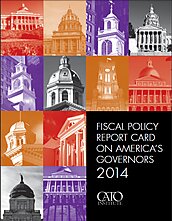That is the backdrop to this year’s 12th biennial fiscal report card on the governors, which examines state budget actions since 2012. It uses statistical data to grade the governors on their taxing and spending records—governors who have cut taxes and spending the most receive the highest grades, while those who have increased taxes and spending the most receive the lowest grades.
Four governors were awarded an “A” on this report card: Pat McCrory of North Carolina, Sam Brownback of Kansas, Paul LePage of Maine, and Mike Pence of Indiana. Eight governors were awarded an “F”: Mark Dayton of Minnesota, John Kitzhaber of Oregon, Jack Markell of Delaware, Jay Inslee of Washington, Pat Quinn of Illinois, Deval Patrick of Massachusetts, John Hickenlooper of Colorado, and Jerry Brown of California.
With the economy currently growing, governors and legislatures are having few problems balancing their budgets in the short run, but the states face major budget challenges down the road. Many retirement plans for state workers have high levels of unfunded liabilities, and the Medicaid expansion under the 2010 Affordable Care Act will increase stress on state budgets. At the same time, global economic competition is making it imperative that states improve their investment climates, particularly by cutting tax rates on businesses and entrepreneurs.
This report discusses those trends and examines the fiscal policy actions of each governor. More state policymakers should be encouraged to follow the reform approaches of the top-scoring governors.



